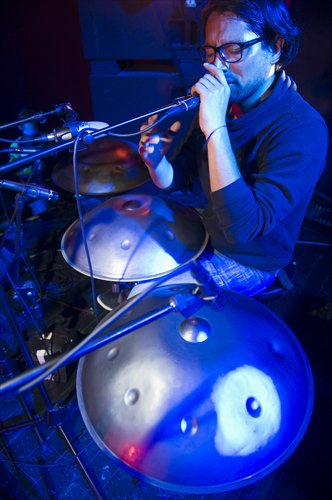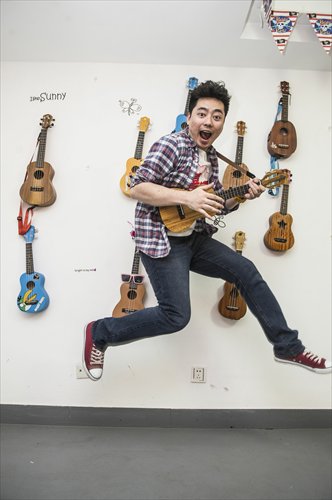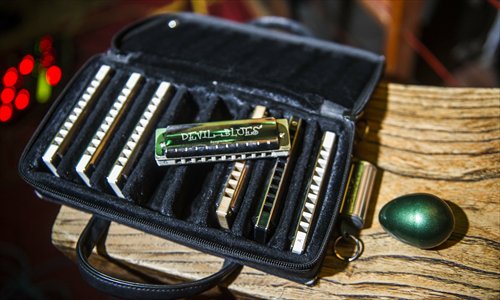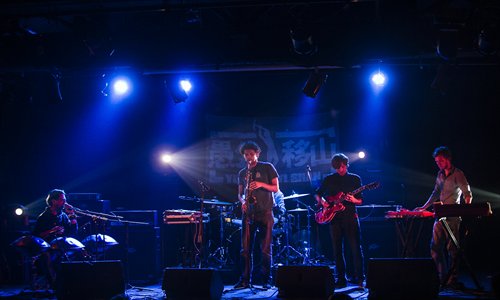Marching to your own handpan

Rafael Sotomayor playing handpan at Yugong Yishan in Beijing. Photo: Li Hao/GT
Rafael Sotomayor from Santiago, Chile, is only 35 years old, but he had visited 50 different countries before he came to China this month. The scenery changes from country to country, but one thing stays the same: the four strange-looking steel pots he carries with him.
Sotomayor is a full-time musician, and these pots have made him famous. They are a new percussion musical instrument, created in the year 2000 in Switzerland, called the handpan. It was inspired by the sound of the musical instrument called the ghatam.
Sotomayor was encouraged by the popularity and welcome he received from Chinese audiences. But he was even more encouraged by the unexpected, fast development of the handpan in China. In fact, Chinese people have been very receptive to all sorts of unexpected musical imports.
Starting to rise
Tang Yan, one of millions of ordinary people living in Beijing, had never done anything crazy until the year of 2009. He spent €2,400 ($3,300) and went all the way to Switzerland to fetch a Hang handpan made by Felix Rohner, the father of the handpan. His brand is the most famous in the handpan world. Hang means "hand" in German dialects in Switzerland.
"It is very hard to get a Hang and I am very lucky to be able to purchase one," said Tang. This is because Hangs are handmade by Rohner, who is already in his 60s. Every year Rohner receives over 100,000 letters from eager buyers, but he only makes about 200.
Handpans are shaped like two pans pressed together along the open part. On the upper pan, there are 7 to 8 small hollows, each with a different tone. The lower pan has a hole to let the air flow through for resonance. Holding his handpan, Tang swiftly tapped the hollows with his fingers, finger joints or palms. This produces a kind of special tone, which was gentle and light, and sounds ancient and mysterious.
Tang said the sound of handpan is rather special. According to Sotomayor, some of his audience even could not believe it is a brand-new instrument. Rather, they say it sounds like "a Chinese one which has a history of more than 2,000 years."
Before 2008, there was barely anyone who knew how to play the handpan in China. Now, there are over 10,000 players in Beijing and more in the whole of China, estimated Tang. He knows many people who have fallen in love with this new musical instrument. Some of them have begun to make their own handpans in China.
Zhang Hua, a former sculptor, has been making handpans for 14 months. He told Metropolitan that he learned how to do it all by himself and it takes him 45 to 60 days to make one handpan. While the Hang made in Switzerland costs about 16,000 yuan($2,600), Zhang sells his handmade handpan to Chinese handpan lovers for only 8,000 yuan.
"It is mainly the labor and craftsmanship reflected in the price," said Zhang. "The material is only two sheets of steel, which is not too expensive. But I have to put my heart into it."
Zhang does not worry about patent problems, because other brands of handpans have been emerging in other countries such as Germany, France, and Italy.

Zhang Songtao playing ukulele at his studio in Chaoyang district, where a whole wall is decorated with ukuleles. Photo: Li Hao/GT
Uke mania
Besides the handpan, there are also other kinds of relatively uncommon musical instruments thriving in China. For example, the ukulele, a small four-string guitar which comes from Hawaii, has become popular among Chinese people, especially the young and children.
Zhang Songtao, a former English teacher at New Oriental, quit a few years ago and opened his own English teaching institution. But his classes are a little different.
As one of the earliest ukulele players in China, he combined ukulele playing with English teaching. "I wrote a lot of songs with useful expressions as the lyrics, and I also teach expats Chinese in the same way," said Zhang Songtao. "It is also a great way to promote ukulele."
Zhang Songtao began to play ukulele in 2006, when there was barely anyone who knew about it. Then he formed a band called the Jolly Fellow Ukulele Band with another ukulele player, an Irish man named Richard Dorian. At the same time he recorded many teaching videos and put them on the Internet. Each video had drawn tens of thousands of clicks. Even though the band is no more active now, Zhang Songtao is still sticking to ukulele and has formed a new band.
"It is hard to play sad songs with it because the sound is gentle, sweet, and lively," said Zhang Songtao, who released an album of his original songs named Life Is Good. All songs included are happy and lively in style, which expresses his optimistic attitude towards life, and also the future development of ukulele in China.
"There are special qualities that made the ukulele become popular," said Zhang Songtao. It is small, inexpensive and simple to learn. On Life Is Good, there is one song in which Zhang Songtao mixed ukulele with another rising musical instrument, blues harp, a 10-hole diatonic harmonica specially made for blues music.

Zhang Xiaosong playing blues harp on a Saturday evening at Salud Bar in Nanluoguxiang. Photo: Li Hao/GT

Zhang Xiaosong's blues harps. Photo: Li Hao/GT
Blow the blues away
Zhang Xiaosong, a teacher of politics in Beijing No. 4 High School, claimed he is the first person who developed the systematic method to teach blues harp in China. In 2003, he created his own blues harp brand. His blues harp website has 150,000 registered users.
With different bending techniques, Zhang Xiaosong can use his blues harp to imitate other musical instruments such as guitar and violin. And the harp is "born to produce a one hundred percent jazz sound," which can be relaxing and comfortable, he said.
"China produces 80 percent of harmonicas in the whole world, but we do not have any top or even middle-range brands, and not many good performers," said Zhang Xiaosong.
When he went to a famous harmonica factory in Jiangsu Province, which provides parts production and assembly for Hohner and Suzuki, the two major harmonica brands, from Germany and Japan, he found no one in that factory could play it, not even an 82-year-old man who had worked there for more than half a century.
"In the traditional Chinese mindset, being an artist or actor is a low and degrading career," he said. "I am a teacher in a key public high school, a kind of 'cultural worker.' My colleagues are all well educated but they do not know music. They even often doubt whether I 'do evil' in the bars and night clubs where I perform."

Two members of Rafael Sotomayor's band, The Art of Fusion. Photo: Li Hao/GT
In with the new
The handpan, ukulele and blues harp can all blend with traditional Chinese musical instruments such as the erhu and guzheng. They fit well in some well-known songs such as Jasmine Flower and The Moon Represents My Heart.
Zhang Songtao says another reason these instruments are getting popular is that some young people are getting bored with KTV, and they want to stand apart from people who play guitar or sit in front of a piano. In addition, parents and schools are beginning to understand the importance of music education and the charm of music. In foreign countries, even some primary schools have school bands.
"Chinese children are always forced by their parents to learn musical instruments systematically, but that is not what music really is. Music is there for people to enjoy, and it should not has any fixed style. Just follow your own heart," said Tang. "And the relatively rare musical instruments are easy to learn, and free in style, which gives Chinese people the chance to feel free and break from the mold."
"China copies everything, and the world knows it," joked Sotomayor. "But I do not mind China copying musical instruments such as the handpan. More and more new musical instruments are coming to China and China is accepting them, which is a great thing I appreciate."